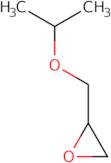Glycidyl isopropyl ether
CAS: 4016-14-2
Rif. 3D-FG166995
| 1kg | Fuori produzione | ||
| 2kg | Fuori produzione | ||
| 100g | Fuori produzione | ||
| 250g | Fuori produzione | ||
| 500g | Fuori produzione |
Informazioni sul prodotto
- (2R)-2-[(1-methylethoxy)methyl]oxirane
- (2S)-2-[(1-methylethoxy)methyl]oxirane
- (Isopropoxymethyl)oxirane
- (Isopropyloxymethyl)oxirane
- 1,2-Epoxy-3-isopropoxypropane
- 2-(Isopropoxymethyl)oxirane
- 2-(Propan-2-yloxymethyl)oxirane
- 2-[(1-Methylethoxy)methyl]oxirane
- 2-[(Propan-2-Yloxy)Methyl]Oxirane
- 3-(Isopropoxy)propylene epoxide
- Vedi altri sinonimi
- 3-Isopropoxy-1,2-epoxypropane
- 3-Isopropyloxypropylene oxide
- Isopropyl glycidyl ether
- NSC 4127
- NSC 46562
- Oxirane, 2-[(1-methylethoxy)methyl]-
- Oxirane, [(1-methylethoxy)methyl]-
- Propane, 1,2-epoxy-3-isopropoxy-
- [(1-Methylethoxy)methyl]oxirane
Glycidyl isopropyl ether (GIE) is a reactive molecule that can exist in the form of an epoxide or coordination complex. GIE has been shown to inhibit collagen synthesis in hamster V79 cells and protein synthesis in human erythrocytes. GIE reacts with nucleophilic groups on proteins, such as hydroxyl groups on lysine residues. It has also been shown to react with phospholipids and form phosphoglycerides. The reaction solution of GIE consists of a neutral pH, which does not affect the rate of reaction. The phase transition temperature for GIE is -22°C, making it a good candidate for cold storage applications. Fluorescence spectrometry has been used to determine the concentration of GIE in solution by measuring its fluorescence intensity.





